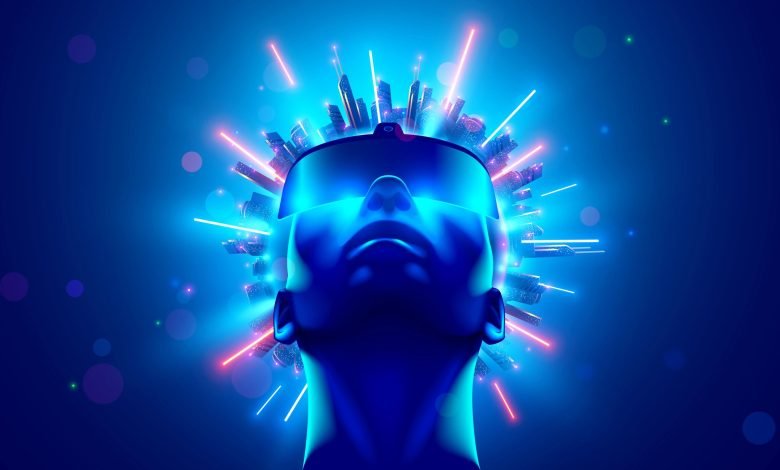Technology
The fundamental building blocks of Metaverse
Digital technologies have completely changed almost every industry in our time. The Internet and related technologies have given rise to an entirely new type of d, with new players at its core, in all areas from communications to media to transportation to retail.
The next revolution will completely alter every aspect of human life and give it a new appearance. These revolutions can be seen through Virtual Reality (VR) and Augmented Reality (AR). According to predictions based on market data, in the United States of America, 58.9 million and 93.3 million people will each experience VR and AR at least once per month in the upcoming year. It makes up between 17.7 and 28.1 percent of the nation’s population.
Surprisingly, the Metaverse, a brand-new universe in and of itself, has many groundbreaking features beyond AR and VR. This article covers various ideas related to the three-dimensional digital world—Metaverse, including VR, AR, Blockchain, NFTs, and much more—in-depth.
With headsets aid, Metaverse Platform Developers provides an immersive and interactive social experience. You suddenly find yourself in a brand-new, three-dimensional world as your avatar when you put on your headset.
This virtual world is known as the Metaverse. Neal Stephenson, an American science fiction author, and philosopher, first used the phrases in his 1992 book Snow Crash.
In essence, the Metaverse is a communal virtual space. It is produced by the fusion of physically persistent virtual space and virtually enhanced physical reality. It is a system of “smart spaces” built on the meeting point of the material and digital worlds. The physical world, the digital world, and the “empty” space surrounding augmented reality (AR) devices like Google Glass make up these spaces.
Users will feel like they are actually in the Metaverse when using it. You can see, feel, and hear as though you were there.
People from all over the world will be able to communicate and interact as if they were in the same room, thanks to the development of this immersive, three-dimensional environment.
This article discusses the emergence and application of the “metaverse” to improve, safeguard, and enhance human life as part of the next-generation Internet revolution. So let’s start by thoroughly comprehending the Metaverse.
Describe the Metaverse.
Anyone can create and manage virtual reality environments and applications on the decentralized Metaverse platform. It is essentially a three-dimensional virtual reality that uses blockchain and cryptocurrency technologies. It enables users to build social networks, share digital assets, and create their own virtual spaces. In a nutshell, it’s a digital environment where anyone can establish and maintain an online persona, fostering the growth of communities.

The main topic of the future of the Internet is how the upcoming blockchain technology will power the Metaverse projects and how that will alter everything.
The next significant advancement in virtual reality is the Metaverse. Others believe that the technologies could include augmented reality and robotics. The standard definition of the Metaverse refers to a virtual reality world where people interact and communicate through avatars. The Metaverse is a world that people will inhabit and give shape in one way or another. It would be something that, as we move into the digital world, we will depend on more and more.
The idea of a virtual world in which people interact and communicate with one another through avatars and in-game contacts is based on the Metaverse’s building blocks. These platforms will serve as the foundation for the Metaverse. The limitations of virtual reality led to the development of the Metaverse.
Thanks to the Metaverse’s fundamental components, you’re about to embark on an exhilarating journey to discover the brand-new virtual world at your disposal.
Blockchain is one of the critical components, but what is it, and is it just a new bubble that will burst soon?
Describe Blockchain.
The Blockchain changed how we conducted business on the Internet even before the Metaverse could exist and completely transformed how we communicate online. Numerous groundbreaking technologies, including NFTs and cryptocurrency, were built on this technology.
What exactly is Blockchain, then? A public digital ledger system called Blockchain can be used to carry out transactions, smart contracts, and other types of agreements. Because every transaction is stored on a distributed database spread across various locations, it is decentralized, which gives it power. It preserves privacy and guarantees data fidelity by recording transactions chronologically and transparently. Furthermore, the public nature ensures control is not held by a single organization.
With Blockchain, we are amidst a technological revolution with a wide range of potential development paths and outcomes. For instance, the rise of different cryptocurrencies offers several benefits, such as security and privacy. Similarly, based on blockchain technology, NFTs are a new type of distinctive digital assets developing a market for themselves.
Interestingly, Blockchain can significantly contribute to the growth and development of third-world nations. For instance, in Timor Leste, villagers can use a blockchain-enabled smartphone to log in to a global labor exchange platform, enter the kind of work they are offering, display their skills, and connect with companies looking to use their services.
Any currency’s value, including that of cryptocurrencies, is directly correlated with how much people trust it. Most currencies in use today are fiat currencies, meaning that a government or central bank backs them. Therefore, they have a lot of public trust. This belief hasn’t been proven in the case of cryptocurrencies. The day does not appear to be too far away, though, given the rapid rate of rising popularity.
What use do cases exist for blockchain technology?
Dealing with blockchain technology is exciting. Voting, prepaid systems, banking, financial transactions, and smart contracts are a few examples of where we already see it in use. These are merely the start.
Despite reservations, Blockchain has the potential to revolutionize financial transactions in the future. The ability to send money without a third-party intermediary, transfer money, and store transaction information transparently present tremendous opportunities.
Like this, voting is another application of blockchain technology, allowing people to exercise their democratic right to vote without giving up control to third parties.
Although it is still in the early stages of development, there are signs that blockchain technology may have different uses. It was taking the capacity to store and arrange data more effectively as an example.
When it comes to emerging technologies, there is still a lot of doubt and misinformation. However, for the time being, we can watch how it is implemented in the financial and electoral sectors and wait idly to see how it affects our larger society.
Apps like Augur and BlockStation improve voting systems’ accessibility, security, and transparency as voting becomes increasingly digitized. Now that Ethereum users can validate transactions on the public ledger, mobile voting stations have an additional layer of trustworthiness.
If Blockchain is ever to be considered successful, more of our social structures will need to adopt it, but for now, these first actions show the technology’s promise.
Additionally, Blockchain plays a unique role in the Metaverse by giving assets their uniqueness by making them authentic and unreplicable. This significantly increases their value, as evidenced by the $560,000 price tag placed on the GIF of the Nyan Cat. This brings us to the other metaverse elements: virtual and augmented reality.
Augmented reality: what is it?
Start with the definition, please. Through computer-generated perceptual data, users can interact with the physical world in an experience known as augmented reality (AR). The physical world is covered in an interactive layer of digital information reflected on the screen. The various filters offered on social media platforms, like Instagram or Snapchat, are among the most prevalent examples.
According to recent statistics, there will be about 1.7 billion mobile AR users worldwide by 2024, up from 1.5 billion in 2015. There will be roughly 1.1 billion mobile AR users worldwide this year, 2022.
The use of 3D computer graphics, video, and audio in our everyday, physical surroundings is known as augmented reality (AR). With their superimposed audio, video, graphics, and text, mobile device applications are frequently used in the context of augmented reality.
By altering how we view it, augmented reality aims to obfuscate the boundaries between the real and virtual worlds. It becomes more comprehensive, more approachable, and limitless as a result.
The 3D digital avatar on the Internet is one of the newest developments in this field of technology that is currently in use. This avatar is you; it’s not just some inconsequential thing on the computer screen.
Finally, we reached our next stop to put a nice bow on everything. We are creating a virtual environment where anything can be made, such as virtual reality.
Virtual reality: What is it?
Virtual reality spaces are the most recent internet craze to grab people’s attention. The users have an immersive experience in a computer-generated environment. Without physically being there, they can use it to understand a place, a circumstance, an event, a job, a thing, or even another person’s life. As a result, it is a potent new medium that can carry a user to a different reality.
Virtual reality (VR) experiences can research human behavior or train people in a setting that closely resembles reality. Because of this, it is used to train experts like pilots and astronauts, to teach people new skills, and even to spur creative thought.
Not only that, but VR is currently becoming more widely accepted. Numerous new VR startups are emerging, and the cost of the technology is decreasing, making it more accessible to the general public.
As an illustration, the Oculus Rift’s consumer model cost about $300 three years ago. At the current price of $199, they are more than $370 when controllers are added.
And now that many VR-only titles have been released, VR is here to stay.
To that end, the NFTs are a third component of the Metaverse that has emerged recently, following AR and VR. We will dispel the doubts in the section that follows.
Also read: Rising Max is best metaverse game development company in USA
Describe NFT.
NFTs, or non-fungible tokens, are data kept on the Blockchain that gives digital assets a special certificate of ownership. NFTs have their exclusive Blockchain, as opposed to cryptocurrencies, which use a shared blockchain and are fungible (interchangeable). It can represent almost anything, including cryptocurrencies, real-world assets, and digital collectibles like in-game items and virtual weapons. The USP of NFTs, which makes them so valuable, is their non-fungibility. Many large companies hired the best NFT marketplace development services for the development of NFT.
They rank among the most intriguing brand-new ideas in the digital sphere. The NFT market is estimated to be around $22 billion by volume. As a digital “collectibles” market, it could one day be worth hundreds of billions of dollars.
NFTs can be used in a variety of ways. Here are a few instances of NFTs:
- Digital artifacts such as GIF files, audio-video, CryptoKitties, and online avatars can be collected.
- Items used in digital games, such as weapons in online games.
- Real-world assets such as the trading website Polymath, as well as tangible examples of digital assets like CryptoKicks
- Unquestionably, CryptoKitties, a game where players can buy, sell, and trade exclusive digital cats, are the most well-known NFT. The game gained so much traction that it crashed the Ethereum network and skyrocketed the price of Ethereum.
Let’s now discuss some additional applications for blockchain technology.
How do Smart Contracts work?
These blockchain-based applications can be use to carry out conventional legal contracts. When predefined conditions are met, they automatically activate. Making the contract execution process transparent gives the parties to the agreement certainty regarding the results. Additionally, because there is no involvement of a third party, both time and money are saved.
The “If or when… then” statement is the foundation for how smart contracts operate. The contract comes into force after the stipulation is satisfy and verify. These agreements can take many different shapes and have a variety of functions, including sending notifications, releasing funds, and registering vehicles. Additionally, the Blockchain is update and cannot be change after the contract is successfully carried out. Decentralized Autonomous Organizations, introduced in 2016, provided yet another application for smart contracts.
Decentralized Autonomous Organizations (DAOs): what are they?
Decentralized autonomous organizations, also known as “DAOs,” are businesses manage by computer algorithms. In a DAO, all decisions are made base on algorithms, unlike traditional organizations where decision-making is frequently centralized. As a result, a DAO is essentially a group of blockchain-based smart contracts. A DAO is essentially a blockchain-based computer program.
DAOs are a subset of DApps (Decentralized Apps), which are pieces of blockchain-base software that can carry out conventional legal contracts (like a smart contract). Human organizations frequently become autonomous computer organizations as a result of DAOs. The concept behind DAOs is that algorithms make decisions rather than a single person or group of people. Such organizations have computer programs that are encode with their governing principles. As a result, it is transparent and predictable and is run by the organization’s members rather than a centralize authority.
Future-proof your steps with Metaverse
Looking around, it appears that the Metaverse is finally taking shape, with a more precise direction, goal, and expectation. Under the aegis of blockchain ecosystems, different platforms concentrate on serving various niche markets.
Blockchain and artificial intelligence are use in Metaverse to guarantee security and build a digital environment beyond the physical world’s bounds. It is a place where you are free to carry out social and commercial activities following your preferences.
Never before has looking into the future been so captivating. Get the best of both worlds by always having powerful technologies at your disposal. With their extensive technological knowledge, Queppelin’s internal subject-matter experts will help you navigate this new world and take advantage of the opportunities.
Web Stories Trendy is a daily online news website covering and curating the latest trends in tech, health, travel, fashion, Guest posting services, entertainment and more. I write blogs and share knowledge to our all visitors you can find any article here or request to post article. Adminlinked .com is a web-based platform that offers businesses a complete suite of tools to manage their online presence.

























